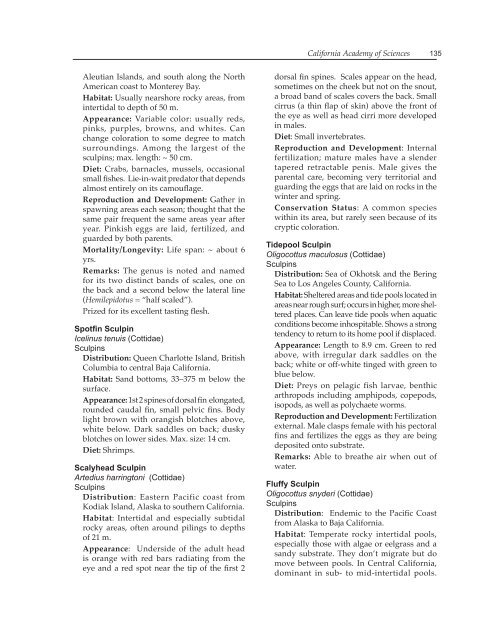THE STEINHART AQUARIUM - Gulf of Guinea Science ...
THE STEINHART AQUARIUM - Gulf of Guinea Science ...
THE STEINHART AQUARIUM - Gulf of Guinea Science ...
Create successful ePaper yourself
Turn your PDF publications into a flip-book with our unique Google optimized e-Paper software.
Aleutian Islands, and south along the North<br />
American coast to Monterey Bay.<br />
Habitat: Usually nearshore rocky areas, from<br />
intertidal to depth <strong>of</strong> 50 m.<br />
Appearance: Variable color: usually reds,<br />
pinks, purples, browns, and whites. Can<br />
change coloration to some degree to match<br />
surroundings. Among the largest <strong>of</strong> the<br />
sculpins; max. length: ~ 50 cm.<br />
Diet: Crabs, barnacles, mussels, occasional<br />
small fishes. Lie-in-wait predator that depends<br />
almost entirely on its camouflage.<br />
Reproduction and Development: Gather in<br />
spawning areas each season; thought that the<br />
same pair frequent the same areas year after<br />
year. Pinkish eggs are laid, fertilized, and<br />
guarded by both parents.<br />
Mortality/Longevity: Life span: ~ about 6<br />
yrs.<br />
Remarks: The genus is noted and named<br />
for its two distinct bands <strong>of</strong> scales, one on<br />
the back and a second below the lateral line<br />
(Hemilepidotus = “half scaled”).<br />
Prized for its excellent tasting flesh.<br />
Spotfin Sculpin<br />
Icelinus tenuis (Cottidae)<br />
Sculpins<br />
Distribution: Queen Charlotte Island, British<br />
Columbia to central Baja California.<br />
Habitat: Sand bottoms, 33–375 m below the<br />
surface.<br />
Appearance: 1st 2 spines <strong>of</strong> dorsal fin elongated,<br />
rounded caudal fin, small pelvic fins. Body<br />
light brown with orangish blotches above,<br />
white below. Dark saddles on back; dusky<br />
blotches on lower sides. Max. size: 14 cm.<br />
Diet: Shrimps.<br />
Scalyhead Sculpin<br />
Artedius harringtoni (Cottidae)<br />
Sculpins<br />
Distribution: Eastern Pacific coast from<br />
Kodiak Island, Alaska to southern California.<br />
Habitat: Intertidal and especially subtidal<br />
rocky areas, <strong>of</strong>ten around pilings to depths<br />
<strong>of</strong> 21 m.<br />
Appearance: Underside <strong>of</strong> the adult head<br />
is orange with red bars radiating from the<br />
eye and a red spot near the tip <strong>of</strong> the first 2<br />
California Academy <strong>of</strong> <strong>Science</strong>s<br />
135<br />
dorsal fin spines. Scales appear on the head,<br />
sometimes on the cheek but not on the snout,<br />
a broad band <strong>of</strong> scales covers the back. Small<br />
cirrus (a thin flap <strong>of</strong> skin) above the front <strong>of</strong><br />
the eye as well as head cirri more developed<br />
in males.<br />
Diet: Small invertebrates.<br />
Reproduction and Development: Internal<br />
fertilization; mature males have a slender<br />
tapered retractable penis. Male gives the<br />
parental care, becoming very territorial and<br />
guarding the eggs that are laid on rocks in the<br />
winter and spring.<br />
Conservation Status: A common species<br />
within its area, but rarely seen because <strong>of</strong> its<br />
cryptic coloration.<br />
Tidepool Sculpin<br />
Oligocottus maculosus (Cottidae)<br />
Sculpins<br />
Distribution: Sea <strong>of</strong> Okhotsk and the Bering<br />
Sea to Los Angeles County, California.<br />
Habitat: Sheltered areas and tide pools located in<br />
areas near rough surf; occurs in higher, more sheltered<br />
places. Can leave tide pools when aquatic<br />
conditions become inhospitable. Shows a strong<br />
tendency to return to its home pool if displaced.<br />
Appearance: Length to 8.9 cm. Green to red<br />
above, with irregular dark saddles on the<br />
back; white or <strong>of</strong>f-white tinged with green to<br />
blue below.<br />
Diet: Preys on pelagic fish larvae, benthic<br />
arthropods including amphipods, copepods,<br />
isopods, as well as polychaete worms.<br />
Reproduction and Development: Fertilization<br />
external. Male clasps female with his pectoral<br />
fins and fertilizes the eggs as they are being<br />
deposited onto substrate.<br />
Remarks: Able to breathe air when out <strong>of</strong><br />
water.<br />
Fluffy Sculpin<br />
Oligocottus snyderi (Cottidae)<br />
Sculpins<br />
Distribution: Endemic to the Pacific Coast<br />
from Alaska to Baja California.<br />
Habitat: Temperate rocky intertidal pools,<br />
especially those with algae or eelgrass and a<br />
sandy substrate. They don’t migrate but do<br />
move between pools. In Central California,<br />
dominant in sub- to mid-intertidal pools.


